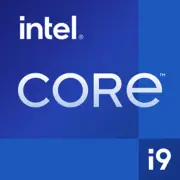Intel Core i9-9960X

Intel Core i9-9960X: In-depth Expertise for 2025
Current analysis of a processor that still finds its fans
Key Features: Architecture and Performance
The Intel Core i9-9960X, released in 2018, is based on the Skylake-X microarchitecture and a 14nm manufacturing process. Despite its age, it remains relevant in 2025 for niche tasks thanks to 16 cores and 32 threads. The frequencies range from 3.1 GHz (base) to 4.4 GHz in turbo mode, and 22 MB of L3 cache speeds up the processing of complex workloads.
Key Features:
- Support for AVX-512 for accelerated scientific computations.
- PCIe 3.0 (up to 44 lanes) — sufficient for multiple GPUs or NVMe drives but falls behind PCIe 4.0/5.0.
- Turbo Boost Max 3.0 — automatic overclocking of the most powerful cores.
Performance:
- In Geekbench 6 (2025), the single-core score is 1432, and the multi-core score is 10707. For comparison, the modern Ryzen 7 7800X3D (8 cores, 5nm) achieves around 2200/15000 but is more expensive.
Compatible Motherboards: Sockets and Chipsets
The i9-9960X uses the LGA 2066 socket and the X299 chipset. In 2025, new motherboards for this socket are not being released, but models like the ASUS ROG Rampage VI Extreme, MSI X299 Gaming Pro Carbon AC, and Gigabyte X299 AORUS Master are still available on the market (prices: $250–400).
Selection Features:
- Quad-channel memory: To achieve maximum performance, 4 or 8 DDR4 modules should be installed.
- VRM and cooling: Due to its 165W TDP, the motherboard should have a robust VRM (for example, 12+ phases) and heatsinks.
- NVMe compatibility: Most X299 boards support 2–3 M.2 slots, but via PCIe 3.0.
Supported Memory Types
The processor works exclusively with DDR4 (up to 2666 MHz without overclocking). In the era of DDR5, this seems outdated, but for professional tasks, quad-channel mode provides an advantage in bandwidth.
Recommendations:
- Optimal size is 64 GB (4×16 GB or 8×8 GB).
- For overclocking, modules with frequencies of 3200–3600 MHz (1.35V) are suitable.
Power Supplies: Calculation Based on Power Consumption
With a TDP of 165W and a peak load of up to 250W (with overclocking), the minimum power supply rating is 750W. For systems with multiple GPUs (e.g., RTX 4080/4090), it's better to opt for 850–1000W.
Selection Criteria:
- 80+ Gold/Platinum certification (efficiency ≥90%).
- Modular cables for convenient assembly.
- Examples: Corsair RM850x ($140), EVGA SuperNOVA 1000 G6 ($180).
Pros and Cons
Pros:
- High multi-core performance for rendering and coding.
- Affordable price on the secondary market ($600–700 for a new unit).
- Reliability of the X299 platform.
Cons:
- 14nm vs. 5–7nm competitors: higher heat generation and power consumption.
- No support for DDR5, PCIe 4.0/5.0, USB4.
- Falls behind new CPUs in single-core tasks (gaming, low-parallelism applications).
Usage Scenarios
1. Workstations:
- 3D rendering in Blender, video editing in DaVinci Resolve.
- Virtualization (32 threads allow running multiple VMs).
Example: A build for a motion design studio: i9-9960X + 128 GB DDR4 + RTX 4090.
2. Gaming:
- The processor handles 4K gaming, but in FHD, it lags behind modern Ryzen 5 7600X or Core i5-14600K.
- "Bottleneck" in CPU-intensive games (e.g., Microsoft Flight Simulator).
3. Multimedia:
- Streaming + encoding without lag.
Comparison with Competitors
- AMD Ryzen 9 5950X (16 cores, 7nm):
Better IPC, supports PCIe 4.0, lower power consumption (105W). Price: $550 (new).
- Intel Core i9-14900K (24 cores, 10nm):
Up to 6GHz in turbo, DDR5 support, but costs $650–700.
- Conclusion: The i9-9960X is advantageous only for purchasing used components or if one already has an X299 motherboard.
Practical Assembly Tips
1. Cooling:
- Liquid cooling system with a 360mm radiator (e.g., NZXT Kraken X73).
- Air cooler: Noctua NH-D15 (maximum compatibility).
2. Case:
- High airflow (Lian Li Lancool III, Fractal Design Meshify 2).
3. Upgrade:
- If PCIe 5.0 or DDR5 is needed, consider moving to the AM5 or LGA 1851 platform.
Final Conclusion: Who is the i9-9960X Suitable for in 2025?
This processor should be chosen by:
- Professionals with a limited budget who need 16 cores for rendering.
- Enthusiasts already owning an X299 motherboard and looking to upgrade their CPU.
- For building a server or workstation focused on multi-threading tasks.
However, for gaming or tasks requiring high single-core performance, it’s better to look at modern processors. The i9-9960X is a powerful tool from the past that can still provide value in the right hands.
Basic
CPU Specifications
Memory Specifications
GPU Specifications
Miscellaneous
Benchmarks
Compared to Other CPU
Share in social media
Or Link To Us
<a href="https://cputronic.com/en/cpu/intel-core-i9-9960x" target="_blank">Intel Core i9-9960X</a>